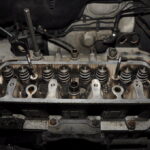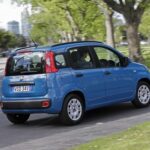Do Mercedes Use Renault Engines? In Which Models?
Mercedes stands as one of the oldest, most respected, and high-end car brands in the world. Naturally, you don’t build this kind of company without making your own world-class engines.
However, times have changed, and so I’ll explain why you’ll sometimes find a Renault engine is lurking under the bonnet.
Do Mercedes Use Renault Engines?
Mercedes uses Renault engines; specifically, several Mercedes cars use Renault’s 1.6-litre four-cylinder diesel engine (known officially as the R-Type engine) and 1.5-litre diesel engine (named the K9K engine).
The 1.6 engine has been used in the Vito medium commercial van. The 1.5, however, has seen more extensive use, having been used in Mercedes smaller range of cars like the A-Class and B-Class. Additionally, there’s the Mercedes and Renault’s co-developed a 1.3-litre gasoline engine.
This small engine is used in Mercedes’ front-wheel-drive cars, such as the A-Class. It’s also used in Renault’s Megane hatchback and Scenic people carrier. It was designed to be highly efficient as diesel sales have been sliding down the sales chart over the years.
With choices of 107bhp, 134bhp, and 161bhp, the little 1.3 was meant to handle the work of being the cheaper option to most engines Mercedes had to offer. That means, if you ever look at the brochure of a smaller Mercedes, you’ll likely find this as the engine choice with the lowest price.
The 1.6 diesel had the job of being a workhorse. Since vans like the Mercedes Vito are used so frequently, it requires an engine that has torque and solid dependability. The 1.6 Renault R-Type engine provides the necessary qualities, having found a home in the Trafic van as well.
Why Do Mercedes Use Renault Engines?
In essence, Mercedes using Renault engines is a means of cutting costs. The engineering partnership set up between Mercedes and Renault in 2010 involved using and co-developing engines as well as cars (the Smart FourFour and Renault Twingo resulted from their combined efforts).
This team-up led to Mercedes taking a 3.1 percent stake in Renault, while Renault and Nissan each got a 1.55 share of Mercedes parent company, Daimler. Originally, the deal entailed just three individual projects together but soon expanded to several more.
Read it: 8 Popular Mercedes Models Depreciation (1-12 Years)
In today’s world, the money involved in designing, developing, testing, and manufacturing cars is always climbing in numbers. Although companies as big as Mercedes can afford the growing costs, their goal remains to make as much profit as possible without spending vast amounts of money.
To help curb spiraling costs, carmakers will go into technical partnerships together. Mercedes and Renault entered such a partnership for this reason. For Mercedes, using Renault engines is convenient for the smaller vehicles in its wide range as it means they won’t need to spend on costly manufacturing for all-new engines.
These partnerships are increasingly common in today’s climate. PSA Group and Toyota got together to make city cars, Ford and Volkswagen recently made a deal to develop commercial vehicles together, and General Motors and Honda have agreed to an EV deal.
These team-ups are also a good way of getting projects off the ground, projects that wouldn’t happen if the company went on its own in making it a reality. In the end, everyone wins as the costs are kept low, there’s no need for all new engines to be made, and valuable engineering knowledge can be shared.
Trending Video: How to Easily Bring Back to Life any Old Car Battery and Save Tons of Money (click to watch)
Are Renault Engines in Mercedes Reliable?
Considering the modern times we live in, yes, they are. In the past, particularly during the 80s and 90s, Renault’s cars cultivated a bad reputation for poor reliability. Fortunately, the 21st century has seen an upturn in form for them, and the carmaker has steadily built an image as an engineer of strong diesel engines.
The 1.6 diesel has a good track record since its introduction in 2011, and the 1.5 diesel has been proven to be a very good long runner.
Check online, and it won’t take long to find people’s positive stories of these engines not letting them down. The key, specifically to the 1.5’s success, is how it’s been in service a while even when Mercedes first started using them. It’s a very tried and tested engine.
This is another reason why Mercedes uses Renault engines. Since they’re known to be reliable, it heavily reduces any risk of major issues that might involve recalling cars. The lack of major problems found in Renault’s engines would make Mercedes as happy as the people wanting to buy reliable cars with their badges on them.
Read it: 10 Car Brands that Last Almost Forever (Unbreakable)
Which Mercedes Models Have Renault Engines?
Mercedes models that use Renault engines are:
- Vito
- C-Class
- A-Class
- B-Class
- Citan
- CLA
- GLA
For the 1.6-litre diesel, it’s found a home in the Vito van and the C-Class saloon. As stated, this engine is good for the endurance-focused life a van normally follows.
The 1.5-litre diesel has seen much wider use. It can be found in the A-Class hatchback, the B-Class MPV, the Citan commercial van, the CLA four-door coupe, and the GLA crossover. This engine is typically found in entry-level versions of these cars.
There’s a particular detail that most of these cars share, and that’s size. Considering how the Renault engines Mercedes uses are small and economical, it makes them a perfect fit for their less bulky cars. At the time of their deal, Mercedes was developing several smaller cars and needed new, low-size engines for them.
The co-developed 1.3 (or M282 engine to use its official name) is meant for the A-Class and B-Class. Sharing the same design as Renault’s H5Ht engine, it’s now spread to being used in the GLB, GLA, and CLA cars.
Mercedes for a first car. Is it a good idea? Which models are the best? Find it out here.
Do Mercedes and Renault Make Engines Together?
Yes, they do. The 1.3-litre gasoline engine is a result of their teamwork towards a small, efficient power plant for small cars. With the work split between the pair, costs were kept lower, and a wide range of cars could get a new engine.
This type of cooperation goes further than engines too. As part of their deal together, a new pair of city cars were greenlit for production. These cars would end up being the third iteration of the Renault Twingo and the mark II Smart Forfour.
Commercial vehicles are also covered by this arrangement. Before making the deal with Renault, Mercedes did not have any small van to sit under the large Sprinter and medium Vito. The Citan and its Renault-derived 1.5 diesel is the solution.
Essentially a restyled Renault Kangoo, it’s made in the same factory in Maubeuge, France, and fills the void in the Mercedes commercial vehicle range. The part of the Mercedes/Renault cooperation will continue into the next generation of Kangoo and Citan vans.
Read it: 18 Cars with Real Leather Seats (with Pictures)
Do Mercedes Use Other Car Brands Engines Too?
As well as Renault engines, Mercedes also utilizes Nissan engines for its X-Class pick-up truck, such as its 2.3-litre diesel. This, too, is part of the deal Mercedes made with Renault as Nissan is in an alliance with the French manufacturer.
Not only does the X-Class find its power from Nissan, but it’s also based on the Navara pick-up. However, its production run ended after three years in 2020 as sales weren’t strong enough to justify making it.
Aside from its arrangements with Renault and Nissan, though, Mercedes has stuck to using its own engines. This only makes sense, seeing how large the company is and the fact they’re one of the most experienced players in the game.
It’s just been very recently that Mercedes has chosen to find assistance powering their smaller, cheaper cars. Renault is a company that’s extremely knowledgable in engines for small cars, so, of course, they would receive interest.
Conclusion
I hope you found this article helpful. While they have traditionally used engines that were primarily their own, the changing, modern economy has seen a manufacturer as big as Mercedes find help towards some major projects.
With a range of compact cars planned over the next few years, they needed compact engines as well as new commercial vehicles to add to their line-up. Renault, a company specializing in small cars, commercial vehicles and little, yet dependable engines, made for a useful partner in achieving those goals.
Through their business deal, Mercedes was able to gain access to ready and reliable diesel engines that fit the bill for cars like their A-Class, B-Class, and CLA. As well as that, they had someone to help develop new engines and cars, such as the 1.3 M282, the Smart Forfour, and the Citan.
With the way inflation and the economy have affected car manufacturers, it’s made alliances more and more vital in order to stay profitable. If you try going it alone in producing new cars with new engines, then the costs can only be very steep. Seeing any Renault powertrain in a Mercedes represents how today’s motoring works: a series of collaborations towards new and reliable vehicles.






